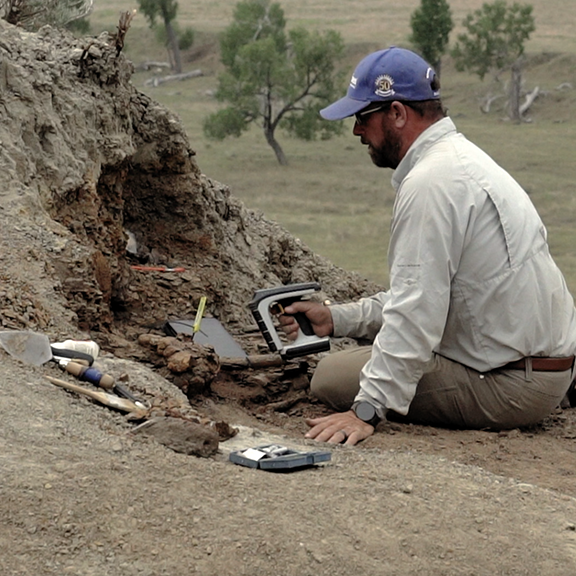Owning fossil history with oral tradition and science
Before paleontologists began scouring indigenous lands for proof of evolution in the fossil record, Native Americans had long since incorporated these “new discoveries” into their cultures. Centuries before Europeans arrived, native inhabitants of the Americas understood that the land had once been teeming with massive creatures that ruled the earth, water and sky. Their distant ancestors had lived alongside mammoths and mastodons, giant sloths, saber-toothed tigers, and giant bison—extinct animals that lived on in Native oral histories backed up by fossils.[1]
Native oral history
Some of these stories identified mastodons as the “grandfathers of the buffalo.” One such tale tells of a wounded warrior who has a vision of the Little People—spirits responsible for protecting humanity—sailing to a swamp, where they ambush a group of giant beasts as the animals rise up from the earth. When the warrior returns home, he shares his vision, inspiring his people to visit the site for themselves. There, they find the bones of the buffalo-like creatures killed by the Little People. That same swamp, now called Big Bone Lick State Historic Site, is where Abenaki guides discovered mastodon fossils in 1739.[2]
Native oral histories are consistent with fossil records. An Abenaki legend tells of Great Elk, a creature so huge that it made other animals seem like ants. It had an extremely tough hide and could walk through eight-foot snow drifts. Great Elk also had a peculiar ‘extra arm’ protruding from its upper body. Some scholars believe that such legends contain actual oral histories of the mastodons and mammoths hunted by Native ancestors.[3]
These oral histories are incredibly important in understanding fossils – a way of looking back in time to picture what it may have been like to live alongside long-extinct species. Early paleontologists used native oral histories to help locate and extract bones from fossil beds. Today, it’s still common to find fossil hunters and even paleontologists removing fossils from Native lands for study or for sale.
A resource under threat
A image of two Native Americans discovering a fossilized mastodon skeleton along a river, from Thomas Bewick’s A General History of Quadrupeds Public domain via Internet Archive
Dr. Lawrence Bradley, an adjunct professor in the Department of Geology and Geography at the University of Nebraska Omaha (a member of the Oglala Lakota Tribe) researched how fossil collectors have been taking specimens from tribal land since Western scientists discovered them in the United States in the mid-1800s. He began researching this topic after he got permission to Santee Sioux Reservation leaders to conduct a survey of what fossils they had on their land. He discovered that a plesiosaur specimen had recently been excavated from the reservation without the knowledge of the tribe. He then conducted surveys of museum and university fossil collections. Based on an educated guess from the museums he surveyed, Bradley said anywhere from 50 to 75 percent of the fossil specimens in those museums’ collections were from tribal land.[4]
Unfortunately, fossils are not covered under the Native American Graves Protection and Repatriation Act, that requires museums and other organizations to return Native American cultural items, including “human remains, funerary objects, sacred objects, and objects of cultural patrimony,” to descendants or tribes. Bradley said that even if dinosaur fossils were returned to their owners, few tribes have either a place to store or resources to manage them.
Standing Rock Sioux Tribe protects its fossils with law and technology
The Standing Rock Sioux Tribe is the first in the nation to create its own paleontology code that sets out rules for fossil collection on its land, according to Benjamin M. Eagle, the fossil preparator for the Standing Rock Sioux Tribe. The code defines a fossil and says that the Standing Rock Sioux Tribe is the owner of all fossils found on its land, “no matter what,” said Eagle.[4]
It’s critical that fossils are protected, identified and tracked to protect Native cultural heritage and to secure and maintain fossil rights as they are excavated for study and display in museums. The Standing Rock Sioux Tribe has recently begun working with the Earth Sciences Foundation, Inc. (ESF) to excavate, identify, tag and manage fossils found on tribal land. This study describes how 347 fossils were excavated, tagged and uploaded into ArcGIS so that the data of fossils can be verified and updated at any time with a quick RFID scan. This GIS data can be shared with partners selected by the Sioux Tribe – from the ESF to university partners.
Tom Hebert, the founder of ESF, describes how the process works in this Esri blog. The tribe has more than 10,000 fossils that require cataloging and this work will continue over the next few years.
Sonya White Mountain, former director of the Standing Rock Institute of Natural History states: “We have so much here, so much that could make an impact if people would...not just come and take advantage and leave,” said White Mountain, “but come and help and invest themselves into us, into our culture, into our resources.”[4]
Footnotes:
[1] From a 2022 essay by Adrienne Mayor https://www.smithsonianmag.com/history/the-first-fossil-finders-in-north-america-were-enslaved-and-indigenous-people-180981615/



